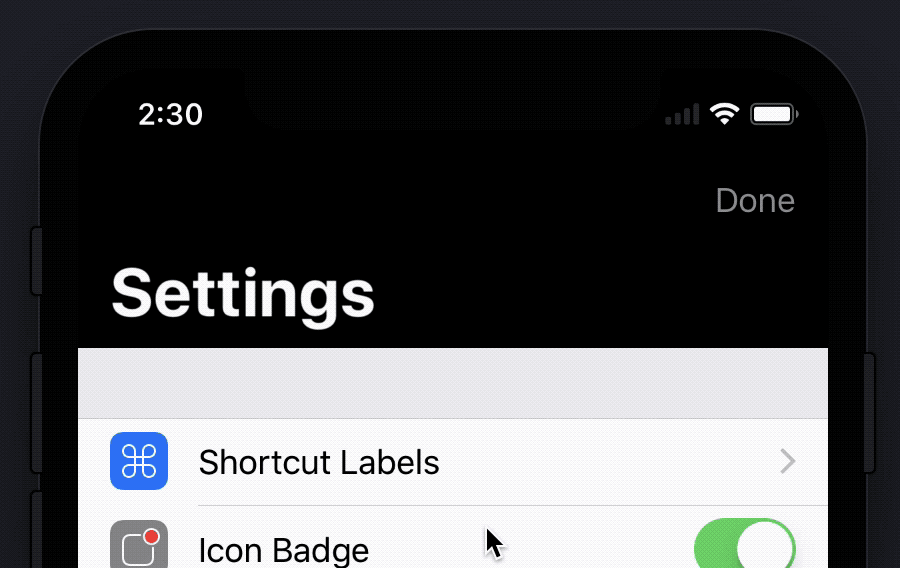iOS 11の大きなタイトルのナビゲーションバーを持つカスタム背景画像
IOS 11の大きなタイトルNavigationBarのカスタム背景画像をどのように設定しますか?ストーリーボードのnavigationControllersに割り当てたカスタムサブクラスを使用しています。
これは、カスタムNavBarを作成する方法です。
_class CustomNavigationController: UINavigationController {
override func viewDidLoad() {
super.viewDidLoad()
// Do any additional setup after loading the view.
self.navigationBar.tintColor = UIColor(red:1, green:1, blue:1, alpha:0.6)
self.navigationBar.titleTextAttributes = [NSForegroundColorAttributeName: UIColor.white]
if #available(iOS 11.0, *) {
self.navigationBar.prefersLargeTitles = true
self.navigationItem.largeTitleDisplayMode = .automatic
self.navigationBar.largeTitleTextAttributes = [NSForegroundColorAttributeName: UIColor.white]
self.navigationBar.barTintColor = UIColor.green
}
self.navigationBar.isTranslucent = false
self.navigationBar.setBackgroundImage(#imageLiteral(resourceName: "navigationBarBackground"), for: .default)
self.navigationBar.shadowImage = #imageLiteral(resourceName: "navigationBarShadow")
}
}
_奇妙なことに、setBackgroundImage(image, for: .default)は大きなタイトルでは機能しません。以前はiOS 10で機能していましたが、iPhoneを回転(および小さなNavBarをアクティブ化)しても背景が戻りますか?
編集:backgroundImageは引き続きレンダリングされますが、何らかの方法で非表示になります。スクロールを開始し、「通常の」ナビゲーションバーが表示された場合のみ、backgroundImageが表示されます。また、この場合、barTintColorは完全に無視されます。 

私は同じ問題を抱えていて、それを修正しました
SetBackgroundImageを削除し、パターン画像でbarTintカラーを使用します
let bgimage = imageWithGradient(startColor: UIColor.red, endColor: UIColor.yellow, size: CGSize(width: UIScreen.main.bounds.size.width, height: 1))
self.navigationBar.barTintColor = UIColor(patternImage: bgimage!)
グラデーションカラーで画像を取得する
func imageWithGradient(startColor:UIColor, endColor:UIColor, size:CGSize, horizontally:Bool = true) -> UIImage? {
let gradientLayer = CAGradientLayer()
gradientLayer.frame = CGRect(x: 0, y: 0, width: size.width, height: size.height)
gradientLayer.colors = [startColor.cgColor, endColor.cgColor]
if horizontally {
gradientLayer.startPoint = CGPoint(x: 0.0, y: 0.5)
gradientLayer.endPoint = CGPoint(x: 1.0, y: 0.5)
} else {
gradientLayer.startPoint = CGPoint(x: 0.5, y: 0.0)
gradientLayer.endPoint = CGPoint(x: 0.5, y: 1.0)
}
UIGraphicsBeginImageContext(gradientLayer.bounds.size)
gradientLayer.render(in: UIGraphicsGetCurrentContext()!)
let image = UIGraphicsGetImageFromCurrentImageContext()
UIGraphicsEndImageContext()
return image
}
IOS 11では、大きなタイトルを使用する場合、BackgroundImage(その宣言を削除)を設定する必要はありません。代わりに、BarTintColorを使用する必要があります。
class CustomNavigationController: UINavigationController {
override func viewDidLoad() {
super.viewDidLoad()
// Do any additional setup after loading the view.
self.navigationBar.tintColor = UIColor(red:1, green:1, blue:1, alpha:0.6)
self.navigationBar.titleTextAttributes = [NSForegroundColorAttributeName: UIColor.white]
if #available(iOS 11.0, *) {
self.navigationBar.prefersLargeTitles = true
self.navigationItem.largeTitleDisplayMode = .automatic
self.navigationBar.largeTitleTextAttributes = [NSForegroundColorAttributeName: UIColor.white]
self.navigationBar.barTintColor = UIColor(red:1, green:1, blue:1, alpha:1)
}
else {
self.navigationBar.setBackgroundImage(#imageLiteral(resourceName: "navigationBarBackground"), for: .default)
}
self.navigationBar.shadowImage = #imageLiteral(resourceName: "navigationBarShadow")
self.navigationBar.isTranslucent = false
}
}
このコードを試してください(Swift 4.0):
viewDidLoad()で
self.navigationController?.navigationBar.titleTextAttributes = [NSAttributedStringKey.foregroundColor: UIColor.black]
if #available(iOS 11.0, *) {
self.navigationController?.navigationBar.prefersLargeTitles = true
self.navigationItem.largeTitleDisplayMode = .automatic
self.navigationController?.navigationBar.largeTitleTextAttributes = [NSAttributedStringKey.foregroundColor: UIColor.black]
} else {
//iOS <11.0
}
self.title = "Title"
self.navigationController?.navigationBar.barTintColor = UIColor(patternImage: #imageLiteral(resourceName: "nav_bg"))
self.navigationController?.navigationBar.isTranslucent = false
Oldrinmendezの答えに便乗-そのソリューションは、水平方向のグラデーションに最適です。
VERTICALグラデーションの場合、scrollViewDidScrollで再度呼び出すことで、oldrinmendezの答えと同じ関数を使用できました。これにより、ユーザーがスクロールするときにグラデーション画像の高さが継続的に調整されます。
oldrinmendezの関数から開始:
func imageWithGradient(startColor:UIColor, endColor:UIColor, size:CGSize, horizontally:Bool) -> UIImage? {
let gradientLayer = CAGradientLayer()
gradientLayer.frame = CGRect(x: 0, y: 0, width: size.width, height: size.height)
gradientLayer.colors = [startColor.cgColor, endColor.cgColor]
if horizontally {
gradientLayer.startPoint = CGPoint(x: 0.0, y: 0.5)
gradientLayer.endPoint = CGPoint(x: 1.0, y: 0.5)
} else {
gradientLayer.startPoint = CGPoint(x: 0.5, y: 0)
gradientLayer.endPoint = CGPoint(x: 0.5, y: 1)
}
UIGraphicsBeginImageContext(gradientLayer.bounds.size)
gradientLayer.render(in: UIGraphicsGetCurrentContext()!)
let image = UIGraphicsGetImageFromCurrentImageContext()
UIGraphicsEndImageContext()
return image
}
必要なオプションで呼び出す更新関数を作成します:
func updateImageWithGradient() {
let navBarHeight = self.navigationController?.navigationBar.frame.size.height
let statusBarHeight = UIApplication.shared.statusBarFrame.height
let heightAdjustment: CGFloat = 2
let gradientHeight = navBarHeight! + statusBarHeight + heightAdjustment
let bgimage = imageWithGradient(startColor: UIColor.red, endColor: UIColor.orange, size: CGSize(width: UIScreen.main.bounds.size.width, height: gradientHeight), horizontally: false)
navigationController?.navigationBar.barTintColor = UIColor(patternImage: bgimage!)
}
最後に更新機能をscrollViewDidScrollとViewDidApperに追加します: ViewDidAppearを使用して、正しいナビゲーションバーの高さが返されるようにします
override func viewDidAppear(_ animated: Bool) {
updateImageWithGradient()
}
override func scrollViewDidScroll(_ scrollView: UIScrollView) {
DispatchQueue.main.async {
updateImageWithGradient()
}
}
BarTintを変更しても機能しなかったので、navigationBar内のレイヤーを変更します
navigationBar.layer.backgroundColor = UIColor(patternImage:
UIImage(named: "BG-Roof1")!.resizableImage(withCapInsets:
UIEdgeInsets(top: 0, left: 0, bottom: 10, right: 0), resizingMode: .stretch)).cgColor
Xamarinでは、次のようになります。
this.NavigationBar.BackgroundColor = UIColor.Clear;
var gradientLayer = new CAGradientLayer
{
Frame = new CGRect(0, 0, UIApplication.SharedApplication.StatusBarFrame.Width,
UIApplication.SharedApplication.StatusBarFrame.Height + this.NavigationBar.Frame.Height),
Colors = new CGColor[]
{Constants.Defaults.Navigation.RealBlueColor.ToCGColor(), Constants.Defaults.Navigation.RealBlueColor.ToCGColor()}
};
UIGraphics.BeginImageContext(gradientLayer.Bounds.Size);
gradientLayer.RenderInContext((UIGraphics.GetCurrentContext()));
UIImage image = UIGraphics.GetImageFromCurrentImageContext();
UIGraphics.EndImageContext();
this.View.Layer.InsertSublayer(gradientLayer, 0);
this.NavigationBar.BarTintColor = UIColor.FromPatternImage(image);
this.View.Layer.Insertはオプションです。 NavigationBarの画像を上下に「カール」しているときに必要です